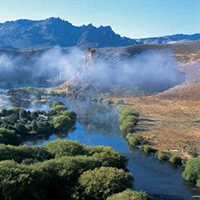Spatial variation of picoplankton communities along a cascade reservoir system in Patagonia, Argentina

Submitted: 29 April 2021
Accepted: 23 July 2021
Published: 3 September 2021
Accepted: 23 July 2021
Abstract Views: 1019
PDF: 222
Supplementary 1: 223
Supplementary 2: 204
HTML: 16
Supplementary 1: 223
Supplementary 2: 204
HTML: 16
Publisher's note
All claims expressed in this article are solely those of the authors and do not necessarily represent those of their affiliated organizations, or those of the publisher, the editors and the reviewers. Any product that may be evaluated in this article or claim that may be made by its manufacturer is not guaranteed or endorsed by the publisher.
All claims expressed in this article are solely those of the authors and do not necessarily represent those of their affiliated organizations, or those of the publisher, the editors and the reviewers. Any product that may be evaluated in this article or claim that may be made by its manufacturer is not guaranteed or endorsed by the publisher.
Similar Articles
- Rossano Bolpagni, Eugenia Bettoni, Francesco Bonomi, Mariano Bresciani, Ketty Caraffini, Silvia Costaraoss, Federica Giacomazzi, Catia Monauni, Paola Montanari, Maria Cristina Mosconi, Alessandro Oggioni, Giovanna Pellegrini, Chiara Zampieri, Charophytes of the lake Garda (Northern Italy): a preliminary assessment of diversity and distribution , Journal of Limnology: Vol. 72 No. 2 (2013)
- Lene Jacobsen, Søren Berg, Henrik Baktoft, P. Anders Nilsson, Christian Skov, The effect of turbidity and prey fish density on consumption rates of piscivorous Eurasian perch Perca fluviatilis , Journal of Limnology: Vol. 73 No. 1 (2014)
- Jacek Radzikowski, Anna Sikora, Mirosław Ślusarczyk, The effect of lake sediment on the hatching success of Daphnia ephippial eggs , Journal of Limnology: Vol. 75 No. 3 (2016)
- Francesca Bona, Valentina La Morgia, Stefano Fenoglio, Luana Morandi, Elisa Falasco, Diatom communities and ecological status classification in the upper Po River basin , Journal of Limnology: Vol. 80 No. 3 (2021): Celebratory Issue - 80th Anniversary of the Journal of Limnology
- Nicole GALLINA, Orlane ANNEVILLE, Martin BENISTON, Impacts of extreme air temperatures on cyanobacteria in five deep peri-Alpine lakes , Journal of Limnology: Vol. 70 No. 2 (2011)
- Barbara LEONI, Letizia GARIBALDI, Population dynamics of Chaoborus flavicans and Daphnia spp.: effects on a zooplankton community in a volcanic eutrophic lake with naturally high metal concentrations (L. Monticchio Grande, Southern Italy) , Journal of Limnology: Vol. 68 No. 1 (2009)
- Michaela M. Salcher, Same same but different: ecological niche partitioning of planktonic freshwater prokaryotes , Journal of Limnology: Vol. 73 No. s1 (2014): Limnology in the 21st Century: celebrating 75 years of ecological research in Pallanza
- Cristina Pulido, Joan Lluís Riera, Enric Ballesteros, Eglantine Chappuis, Esperança Gacia, Predicting aquatic macrophyte occurrence in soft-water oligotrophic lakes (Pyrenees mountain range) , Journal of Limnology: Vol. 74 No. 1 (2015)
You may also start an advanced similarity search for this article.

 https://doi.org/10.4081/jlimnol.2021.2027
https://doi.org/10.4081/jlimnol.2021.2027





